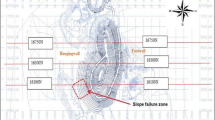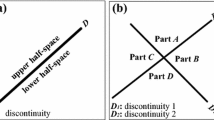Abstract
The stability of rock slopes under dynamic loading in mining and civil engineering depends upon the slope geometry, mechanical properties of rock mass and discontinuities, and the characteristics of dynamic loads with time. The wedge failure is one of the common forms of slope failures. The authors presented some stability conditions for rock wedges under dynamic loading and they confirmed their validity through the laboratory experimental studies in a previous paper in 2000, which is often quoted by others to validate their softwares, including some commercial software. In this study, the authors investigate the sliding responses of rock wedges under dynamic loads rather than the initiation of wedge sliding. First, some laboratory model tests are described. On the basis of these model tests on rock wedges, the theoretical model proposed previously is extended to compute the sliding responses of rock wedges in time domain. The proposed theoretical model is applied to simulate the sliding responses of rock wedge model tests and its validity is discussed. In the final part, the method proposed is applied to actual wedge failures observed in 1995 Dinar earthquake and 2005 Pakistan–Kashmir earthquake, and the results are discussed.











Similar content being viewed by others
References
Aydan Ö (1987) A note on the seismic stability of discontinuous rock slopes. Interim report, December 7, Geotechnical Engineering Department, Nagoya University, p 16
Aydan Ö (2006) Geological and seismological aspects of Kashmir earthquake of October 8, 2005 and a geotechnical evaluation of induced failures of natural and cut slopes. J Mar Sci Technol, Tokai University 4(1):25–44
Aydan Ö (2009) Characteristics of large-scale rock slope failures induced by recent worldwide earthquakes. XVIIth international conference on soil mechanics and geotechnical engineering, Earthquake Geotechnical Engineering Satellite Conference, Alexandria (in press)
Aydan Ö, Hamada M (1992) The site investigation of the Erzincan (Turkey) Earthquake of March 13, 1992. The 4th Japan–US workshop on earthquake resistant design of lifeline facilities and countermeasures against soil liquefaction, Honolulu, pp 17–34
Aydan Ö, Hamada M (2006) Damage to civil engineering structures by Oct. 8, 2005 Kashmir earthquake and recommendations for recovery and reconstruction. J Disaster Res 1(3):1–9
Aydan Ö, Kawamoto T (1987) Toppling failure of discontinuous rock slopes and their stabilisation (in Japanese). J Jpn Min Soc 103(1197):763–770
Aydan Ö, Kawamoto T (1992) The stability of slopes and underground openings against flexural toppling and their stabilisation. Rock Mech Rock Eng 25(3):143–165
Aydan Ö, Kumsar H (1997) A site investigation of Oct. 1, 1995 Dinar Earthquake. Turkish Earthquake Foundation, TDV/DR 97-003, 115 p
Aydan Ö, Kumsar H (2002) An experimental and theoretical approach on the modelling of mechanical response of rock wedges under dynamic loading (in Turkish). In: 6th rock mechanics symposium of Turkey, Konya, pp 235–242
Aydan Ö, Ulusay R (2002) A back analysis of the failure of a highway embankment at Bakacak during the 1999 Düzce–Bolu earthquake. Environ Geol 42:621–631
Aydan Ö, Shimizu Y, Ichikawa Y (1989) The effective failure modes and stability of slopes in rock mass with two discontinuity sets. Rock Mech Rock Eng 22(3):163–188
Aydan Ö, Kumsar H, Ulusay R, Shimizu Y (1997) Assessing limiting equilibrium methods (LEM) for slope stability by discrete finite element method (DFEM). IACMAG, Wuhan, pp 1681–1686
Aydan Ö, Ulusay R, Kumsar H, Sönmez H, Tuncay E (1999) A site investigation of June 27, 1998 Adana–Ceyhan Earthquake. Turkish Earthquake Foundation, TDV/DR 99-003, 180 p
Aydan Ö, Ulusay R, Kumsar H, Tuncay E (2000a) Site investigation and engineering evaluation of the Düzce–Bolu earthquake of November 12, 1999. Turkish Earthquake Foundation, TDV/DR 09-51, p 220
Aydan Ö, Seiki T, Shimizu Y, Hamada M (2000b) Some considerations on rock slope failures due to earthquakes. Chonquing–Waseda joint seminar on chi-chi earthquake, pp 51–60
Aydan Ö, Kumsar H, Ulusay R (2000c) An approach for earthquake occurrences in Western Anatolia through GPS. In: Symposium on seismicity of West Anatolia, Izmir, pp 279–292
Aydan Ö, Hamada M, Suzuki Y (2005a) Some observations and considerations on the damage induced by the tsunami of the 2004 Sumatra earthquake on structures and coast. J Sch Mar Sci Technol 3(1):79–94
Aydan Ö, Miwa S, Kodama H, Suzuki T (2005b) The Characteristics of M8.7 Nias Earthquake of March 28, 2005 and Induced Tsunami and Structural Damages. J Sch Mar Sci Technol, Tokai University 3(2):66–83
Aydan Ö, Sakoda S, Kumsar H (2006a) Stability of slopes under dynamic loading and its modelling. In: Symposium on modern applications of engineering geology, Turkish National Group of Engineering, Denizli, pp 101–109
Aydan Ö, Daido M, Ito T, Tano H, Kawamoto T (2006b) Prediction of post-failure motions of rock slopes induced by earthquakes. In: 4th Asian rock mechanics symposium, Singapore, Paper No. A0356 (on CD)
Aydan Ö, Hamada H, Konagai K (2006c) An evaluation of strong ground motions and failures of natural and cut slopes induced by Kashmir Earthquake of October 8, 2005. In: 1st European conference on earthquake engineering and seismology. Paper No. 1352 (on CD)
Aydan Ö, Hamada M, Sakamoto A (2007) Characteristics of Noto Peninsula earthquakes with an emphasis on induced geotechnical damage. J Sch Mar Sci Technol 5(2):13–31
Aydan Ö, Ulusay R, Atak VO (2008) Evaluation of ground deformations induced by the 1999 Kocaeli earthquake (Turkey) at selected sites on shorelines. Environ Geol 54:165–182
Aydan Ö, Ohta S, Hamada M (2009) Geotechnical evaluation of slope and ground failures during the 8 October 2005 Muzaffarabad Earthquake, Pakistan. J Seismol. doi:10.1007/s10950-008-9146-7
DAD-ERD (1995) Earthquake Research Department of Turkey. http://www.deprem.gov.tr
Hoek E, Bray JW (1981) Rock slope engineering, 3rd edn. Inst Min Metall, London, p 358
Kovari K, Fritz P (1975) Stability analysis of rock slopes for plane and wedge failure with the aid of a programmable pocket calculator. In: 16th US Rock Mechanics Symposium, Minneapolis, USA, pp 25–33
Kumsar H, Beyaz T, Aydan Ö (1997a) A study on wedge failures occurred during Dinar Earthquake of Oct. 1, 1995. In: The 4th national earthquake engineering conference, pp 112–122
Kumsar H, Aydan Ö, Sakoda S (1997b) Model wedges tests and re-assessment of limiting equilibrium methods for wedge sliding. Rock mechanics and Environmental Geotechnology—RMEG, pp 261–266
Kumsar H, Aydan Ö, Ulusay R (2000) Dynamic and static stability of rock slopes against wedge failures. Rock Mech Rock Eng 33(1):31–51
Okawa I (2005) Strong earthquake motion recordings during the Pakistan, 2005/10/8. http://www.bri.go.jp/
Shimizu Y, Aydan Ö, Ichikawa Y, Kawamoto T (1986) A model study on dynamic failure modes of discontinuous rock slopes. In: International symposium on engineering complex rock formation, Beijing, pp 732–738
Shimizu Y, Aydan Ö, Ichikawa Y, Kawamoto T (1988) The stability and failure of discontinuous rock slopes (in Japanese). J Civil Eng Geotech Div 400-III-10:189–198
Swedge (2006) http://www.rocscience.com/downloads/swedge/. Probabilistic analysis of the geometry and stability of rock wedges. Verification manual
Tonon F, Asadollahi P (2008) Validation of general single rock block stability analysis (BS3D) for wedge failure. Int J Rock Mech Min Sci 45:627–637
Wittke W (1967) Influence of the shear strength of joints on the design of prestressed anchors to stabilize a rock slope. Geotechnical Conference, Oslo, Paper No. 4.11, pp 311–318
Yeung MR, Jiang QH, Sun N (2003) Validation of block theory and three-dimensional discontinuous deformation analysis as wedge stability analysis methods. Int J Rock Mech Min Sci 40(2):265–275
Author information
Authors and Affiliations
Corresponding author
Rights and permissions
About this article
Cite this article
Aydan, Ö., Kumsar, H. An Experimental and Theoretical Approach on the Modeling of Sliding Response of Rock Wedges under Dynamic Loading. Rock Mech Rock Eng 43, 821–830 (2010). https://doi.org/10.1007/s00603-009-0043-3
Received:
Accepted:
Published:
Issue Date:
DOI: https://doi.org/10.1007/s00603-009-0043-3




